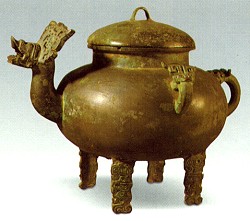Much bronzeware of the Shang Dynasty was decorated with animal patterns. The most popular animal pattern of the time was the taotie with its horns, paws and tail. This imaginary creature was an exaggerated combination of a cow,tigerand sheep. Another popular animal pattern of the period was the kui which had horns, one leg and a curling tail. Kui patterns were mostly used on the decorative bands on the bronzeware. The animal patterns on ancient Chinese bronzeware are humanized figures of animals. The Chinese ancestors wanted to use wild animal designs to symbolize the deities, since the deities had the power of summoning forces to defend against natural disasters and other invading tribes. The idea of combining human and animal figures to form deity patterns signifies that the Chinese of the time were becoming civilized.

By the mid WesternZhou Dynasty, decorations on bronzeware had changed to ring and ripple patterns. The vessels began to have lids, handles and ears; the three-dimensional animal patterns that had then appeared were carved on these parts.
From their fertile imagination, the ancient Chinese slaves created the splendid traditional Chinese bronzeware culture, even though they had no human freedom. The beautiful and complicated patterns on the bronzeware reveal the craftsmen's wisdom and superb skills. They reflect the essential concepts of Chinese Slavery Society and are rare historical relics.
